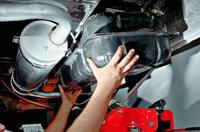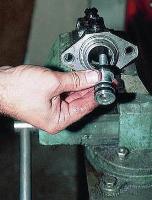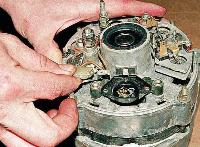If there are noises and knocks in a running engine, you should find out the cause of their occurrence and do not operate the engine until the malfunction is eliminated
In a cold engine, after starting, knocking of valve lifters and hydraulic tensioners may occur.
As the engine warms up to operating temperature, but no more than after 30 minutes, knocking should disappear.
- 2. Do not overheat the engine. If the coolant overheat warning light comes on, immediately stop the engine, identify and eliminate the cause of overheating.
- 3. Do not operate the engine with the emergency oil pressure warning light on.
This will lead to scuffing of the bearings of the crankshaft, camshaft and failure of the gas distribution mechanism.
Illumination of the signaling device is allowed when the engine is running at the minimum speed in idling mode and during heavy braking.
- 4. Do not operate the engine with the diagnostic lamp on.
The constant burning of the lamp indicates the presence of malfunctions in the engine control system. It is necessary to diagnose the system and fix the problem as soon as possible.
Examples of possible causes of engine failure
- Cause of malfunction
Remedy
Engine won't start:
- Fuel supply interrupted
Check fuel pump fuse
- fuel pump does not work
Check the condition of the contacts in the connections of the pump, pump relay and start relay
- broken valve timing
Restore phases at the service station
- the pressure reducing valve of the fuel system has failed
Replace valve
- clogged fuel filter
Replace filter
Faulty ignition system:
- broken contact in the circuits of the ignition coils and the control unit
Restore contact
- ignition coil failed
Replace coil
Engine running erratically:
- Water intrusion into the fuel tank
Drain the sludge from the tank
- Air leakage through leaks in the intake system, crankcase ventilation or idle speed control
Fix leaks in joints
Interruptions or failure of one of the cylinders:
- carbon deposits on a candle or failure of a candle
Clean carbon deposits or replace spark plug
- the contact of the nozzle is broken or the nozzle is out of order
Restore contact or replace nozzle
- spark plug tip broken
Replace Tip
- faulty control unit
Replace block
Interruptions or failure of two cylinders:
- faulty ignition coil
Replace coil
- faulty control unit
Replace Block
High idle speed with warm engine:
- Leakage in the hose connections of the crankcase ventilation system and the idle speed controller
Fix leaks in joints
- The contact of the idle speed regulator is broken or the regulator is out of order
Restore contact or replace regulator
- The contact of the sensors of the engine management system is broken or the sensors fail
Restore contact or replace faulty sensors
Increased toxicity of exhaust gases:
- CO adjustment is broken
Adjust the CO content with the adjusting screw on the mass air flow sensor
- The tightness of the valves is broken
Lap the valves
- Worn oil seals
Replace caps
- The contact of the coolant temperature sensor is broken or the sensor is out of order
Restore contact or replace sensor
- CO adjustment is broken
Adjust the CO content with the adjusting screw on the mass air flow sensor
- The tightness of the valves is broken
Lap the valves
- Worn oil seals
Replace caps
- The contact of the coolant temperature sensor is broken or the sensor is out of order
Restore contact or replace sensor
- Wear of parts of the cylinder-piston group
Repair the engine
Engine not developing full power:
- Air filter dirty
Replace filter element
- Clogged fuel filter
Replace filter
- Air throttle not opening fully
Adjust damper actuator
- Decreased performance of the fuel pump
Replace pump
Engine overheating:
- The tension of the water pump and generator drive belt has loosened
Adjust belt tension
- Faulty thermostat
Replace thermostat
- Insufficient amount of fluid in the engine cooling system
Add coolant
- Severe contamination of the radiator
Rinse the radiator with a jet of water
- Faulty electric fan
Check fan motor, sensor and relay. Replace defective nodes
- Faulty water pump
Replace pump
Lower oil pressure:
- Malfunction or clogging of the oil pump pressure reducing valve
Rinse valve parts or replace defective parts
- Engine overheating
Remove the cause of overheating
- Wear of oil pump parts
Replace pump
- Wear of the main bearing shells
Replace Earbuds
Increased oil consumption:
- Worn or coked piston rings
Repair the engine
- The crankcase ventilation system is broken
Rinse system parts
- Worn oil seals
Replace caps
- Oil leakage through gaskets and seals
Fix the leak, if necessary, replace the seals
Knock - in the engine:
- The hydraulic pusher is out of order
Replace hydraulic tappet
- The hydraulic chain tensioner is out of order
Replace hydraulic tensioner
- Worn connecting rod and piston group
Repair the engine
- Worn chain tensioner shoe
Replace shoe











